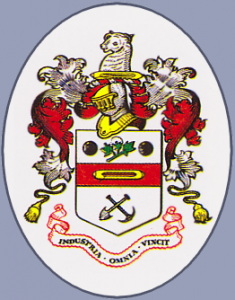Morley’s Heritage and Trail Walks
Topics
Coat of Arms
Heritage – General
Heritage Trail Walk 1
This section deals with principal points of Morley’s heritage and it will be developed as other Heritage Trails are organised.
The Coat of Arms
This was designed for the new borough in 1886, to reflect the town’s heritage and manufacturing links. The cannon balls represent the Civil War conflicts of 1643; the cotton plant and the shuttle represent the textile industry and the pickaxe represents coal mining. The motto ‘Industria omnia vincit‘ translates from Latin as ‘Industry conquers All’.
General history
Morley’s known history goes back to Anglo Saxon times: It started as an agricultural village and became part of the Morley Wapentake – a large administrative area.
Following the Battle of Bannockburn in 1314, Scots swept into the northern counties and Morley was one of the places which lay in their path. A division of Scots wintered there and, around 1323 left the town in ruins.
One of the town’s landmarks was Howley Hall. Built in 1590 by Sir John Savile, Howley Hall was one of the largest buildings in West Yorkshire. In 1626 Leeds was granted a charter for the city and Sir John Savile became Mayor. The owls from his family coat of arms are now incorporated in the Leeds coat of arms. With famous connections to the civil war, Howley Hall was demolished in 1730 and the site now hosts a golf course.
Another notable landowner was Lord Dartmouth. In 1706 he bought the Manor of Morley from the Savile Family. The Dartmouth family provided land and finance for Dartmouth Park, the rugby and cricket grounds and other places for local people.
The village grew around its central highway, Middlethorpe which became Queen Street in later times. Around this area there are seven principal hills. The locals liked the similarity with Rome and made a point of it when talking of the town. These hills are: Scatcherd Hill, Dawson Hill, Troy Hill, Banks Hill, Daisy Hill and Hungerhill.
Until the early 1800s Morley remained a largely agricultural settlement. Owing to the poor quality of the soil, farmers supplemented their income by having weaving looms in their homes. The earliest mills were located on two series of becks and harnessed water as a cheap power source. Crank Mills, built in 1790, was one of the first steam-powered mills in Britain.
Weaving, and especially production of a cheap wool known as “Shoddy” led to Morley’s success during the Industrial Revolution. In its heyday, Morley had 44 mills and during the two World Wars, “Morley Shoddy” was used as cloth for uniforms and blankets. Reputedly, during the American Civil War a Morley mill supplied cloth to both sides but so far we have no definite proof of this.
Mill owners grew rich and powerful and were proud of their self-contained community. These powerful local families included Scatcherds, Dawsons, Websters, Rhodes and Scarths. They worked together in many civic projects but underneath there was long standing, inter-family rivalry.
The buildings erected in the Victorian period used locally-quarried sandstone and provided significant local employment. In addition to its woollen trade, Morley produced a lot of coal in the 19th and early 20th centuries. The last pit in Morley closed in 1927 and coal was mined in the borough, (at East Ardsley) until the late 1960s.
The town grew from 2,108 residents in 1801 to 24,800 in 1901. Its current population is approximately 60,000 (2007). The Textile Industry became practically extinct as a result of foreign competition by 1980.
Morley was the birthplace of Herbert Henry Asquith, Prime Minister from 1908-16 whose ancestors are buried in the town’s Rehoboth Churchyard on Dawson Hill. Other famous people associated with the town can be found here.
Since 1974 Morley has become part of Leeds municipal area. With good access to local motorways it is set towards new development and a bright future.
These heritage trails are aimed at encouraging awareness of Morley’s past by inviting people to look behind the frontage of modern buildings and delving into their past history.
The first trail is roughly 3 miles long, on moderately hilly terrain so people following it are advised to pace their walk and wear suitable footwear.
We have now published a book and DVD to accompany this trail giving all the history and stories you need for full enjoyment of the walk. They are available to order through our Shop page.
Heritage Trail – Walk 1
This heritage trail was developed by Morley Local History Society in the early 1970s but we revised it in the new millennium and our first Chair, Councillor Joe Tetley, led it for a good number of years.
It is aimed at encouraging awareness of Morley’s past by inviting people to look behind the frontage of modern buildings and delving into their past history. The trail is roughly 3 miles long, on moderately hilly terrain so people following it are advised to pace their walk and wear suitable footwear.
We have now published a book and DVD to accompany the trail, giving all the history and stories you need for full enjoyment of the walk. They are available to order through our Shop page.
Click the numbered points for more information.


You must be logged in to post a comment.